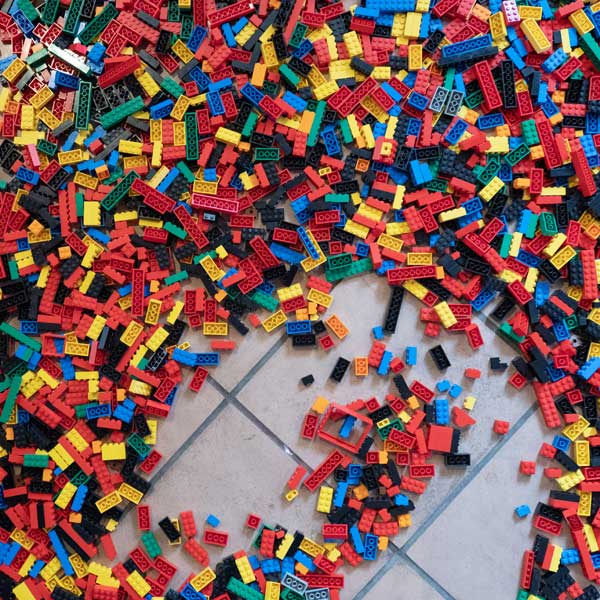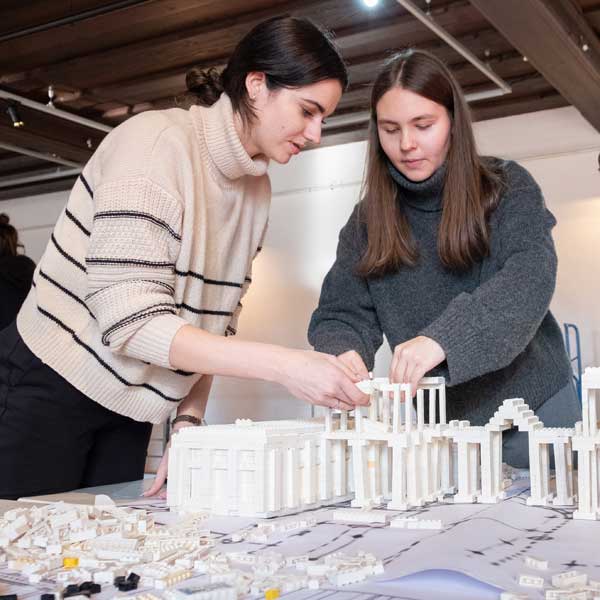Editorial
Janez P. Grom1, Kristjan Lavtižar2: Colorful Creativity Game Read more ...
1 University of Ljubljana, Faculty of Architecture, Slovenia, 2 University of Ljubljana, Faculty of Architecture, SloveniaWrapping up the 2022 issue, we ended the year with an exciting collaboration with the Museum of Architecture and Design (MAO). With a large supply of LEGO bricks recently donated to the Museum by Mija Razpotnik, we came up with the idea of organising a student workshop on recreating Plečnik's works with this simple but eternal toy. The post-COVID-19 period was marked by every form of creativity - scientific, artistic, professional and pedagogical. In 2022, working with students was still subjected to COVID-19 restrictions, and socialising while studying had largely come to a standstill.
It's hard to think of children's toys today without thinking of LEGO bricks. They are so widespread that there is hardly any part of the world where they are not available, and they have been embedded as part of the culture in Western society for decades. It always begins with a colourful, brightly printed box, that promises lots of things. Indeed, inside the carefully stacked bags are the building blocks, the bricks, which as themselves are still far from the final image. The box also contains a booklet of either short or very extensive instructions, but always depicted in a simple, step-by-step manner, leading to the result. Some kits offer instructions which can create different results by using the same bricks. But there is always the option to start building on your own without the help of this booklet, in which case the possibilities are potentially endless. It is not difficult to draw parallels with urbanism, as buildings and space are often the results that come from using LEGO bricks. The process of assembling these bricks is also reminiscent of architecture. It starts with simple elements which, by the very way they are stacked and the strict order of the studs, determine the way they are assembled, limiting the number of variations. An understanding of scale, quantity, symmetry, basic patterns, and geometry is essential. It is perhaps the scale that is most important, because with the right scale we can use any shape or colour of a brick to get close enough to reality. Besides, in the process of building with bricks, the space is rasterised, pixelated, and abstracted. The builder is therefore trying to get closer to his idea within the rules of the game he is struggling with, just as architects and urban planners do when faced with spatial regulations, technical guidelines, or norms. And just as the LEGO builder follows the instructions, the actual builder follows the plan. The process of assembling is special, however, because it is an additive process, where elements are always being added and combined with each other; but when disassembling, we encounter several problems. The additive process is also special because it makes it impossible to simply go back to the previous steps, so that combining two bricks requires a, let's say, serious engineering consideration. This makes it much easier to assemble than to disassemble the bricks, which can be a real challenge, sometimes requiring breaking a part of the model and going back several steps. Careful consideration beforehand is therefore essential to ensure that mistakes can still be corrected. This is foreign to the modern way of working, as reverting to earlier steps is now an accepted fact in the computer environment.
In a workshop that will require the collaboration of student teams throughout the year, the students took their first steps to learn about the works of the architect Plečnik. Rightly so, as the opening of the Plečnik exhibition at the MAO at the time of the 150th anniversary of his birth gave the students access to exceptional archival data that have been used to create "LEGO interpretations" of the architect's masterpieces. Thanks to all the possibilities of the bricks, there is no project of the architect's corpus that could not be properly interpreted with them. Projects that have already been taken on include the National and University Library, Vegova Street, the Žale Cemetery and the Triple Bridge. Continuing this work, young visitors to the MAO will be able to playfully get to know the heritage of Ljubljana's architecture and urbanism through several distinctive periods and in the light of the miniaturisation of other established architects who have made their mark on the city.
Therefore, this 2022 edition of the magazine is also composed in the spirit of the additive process. The selection of articles and other contributions is drawn together from the wide range of topics presented in this journal, in light of the critical reflection and integration of disciplines and diverse criteria.
Papers
Adelina Fejza, Gregor Čok:
Spatial Elements That Create The Quality Public Space
 IU/CG, 10/2022, 14-21. https://doi.org/10.15292/IU-CG.2022.10.014-021
IU/CG, 10/2022, 14-21. https://doi.org/10.15292/IU-CG.2022.10.014-021
Martina Zbašnik-Senegačnik, Ljudmila Koprivec:
The Importance of the Classroom's Window View
 IU/CG, 10/2022, 22-28. https://doi.org/10.15292/IU-CG.2022.10.022-028
IU/CG, 10/2022, 22-28. https://doi.org/10.15292/IU-CG.2022.10.022-028
Rrona Berisha, Ilka Čerpes:
The Social and Spatial Aspect of Public Spaces - Through the Analysis of Ali Madanipour’s Works
 IU/CG, 10/2022, 30-35. https://doi.org/10.15292/IU-CG.2022.10.030-035
IU/CG, 10/2022, 30-35. https://doi.org/10.15292/IU-CG.2022.10.030-035
Domen Kušar, Kristijan Lavtižar:
Roof Color as a Factor of Architectural Landscape Design
 IU/CG, 10/2022, 36-43. https://doi.org/10.15292/IU-CG.2022.10.036-043
IU/CG, 10/2022, 36-43. https://doi.org/10.15292/IU-CG.2022.10.036-043
Rrona Berisha, Matevž Juvančič:
Open Source Urbanism – Adapting Principles and Criteria of Open Source Software To Urbanism
 IU/CG, 10/2022, 44-51. https://doi.org/10.15292/IU-CG.2022.10.044-051
IU/CG, 10/2022, 44-51. https://doi.org/10.15292/IU-CG.2022.10.044-051
Tomaž Slak:
Role and Importance of the City Architect Institute in the Paradigm of Spatial Planning of Small Municipalities in Slovenia
 IU/CG, 10/2022, 52-60. https://doi.org/10.15292/IU-CG.2022.10.052-060
IU/CG, 10/2022, 52-60. https://doi.org/10.15292/IU-CG.2022.10.052-060
FULL VOLUME
PDF (6.29M) DOI: 10.15292/IU-CG.2022.10

